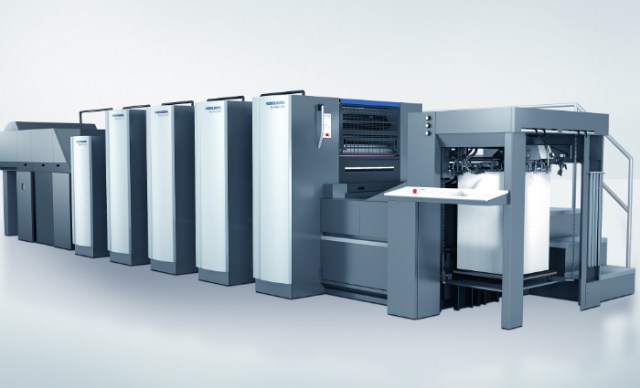Automatic blanket wash and impression cylinder wash meant that makeready times were slashed and its top speed of 15,0000 sheets per hour (sph) was impressive for its time.
Superseding the GTO 52 but not replacing it, the SM 52 was more automated and technology-driven compared with the GTO. “The GTO 52 was manual and had very little automation but they are still selling well – not so much in the UK market but in emerging countries,” says Bradley. “In this country we don’t really sell GTOs any more but the SM 52 still does well. It terms of performance, the SM 52 was said to be the equivalent of two GTO units.”
Heidelberg made several improvements to the press from 1997-1998, with a perfector version launched as well as coating units. Its colours increased from four to five and then to six-colour with coating, as well as an eight-colour with perfecting in 1998. Today, the machine is available as a 10-colour perfector, alongside a new Anicolor version with Anicolor inking units.
In 1998 the entry-level E version was launched. “We trimmed the features down to make it affordable,” says Bradley. The speed of the E model was stripped down to 13,000sph. This version of the press was manufactured until 2004 when it was changed to the Printmaster 52. On the Printmaster, most of the aspects of automation are optional.
That machine will appeal more to the general jobbing printer, while the SM 52 has more of an appeal for those who require more specialist applications, such as inline die-cutting, coating or long perfecting.
“Since 2007 we have been manufacturing PM 52s in our Chinese factory for the Chinese market,” says Bradley. However Chinese-built machines are not available outside of China. “You’ll never find a Chinese manufactured one in the secondhand market in the UK. However, this may not stay that way in around three years,” he adds.
On the one- to four-colour models EasyPlate was fitted as standard and AutoPlate was available as an option. Later models, such as the six- to 10-colour perfecting machines, came with Autoplate as standard.
A post-2004 model is a sensible purchase because the specification was improved that year, making it far more industrial. Heidelberg can source spares for machines made as early as 1995.
“A good tip for potential buyers is to ask for a ‘dry solid’ to be printed,” says Bradley. This pulls ink straight off the blanket for a solid colour. The sheet should be covered in ink, so if there’s a dent in the cylinder it will be apparent.
SPECIFICATIONS
Max sheet size 370x520mm
Pile Heights
Feeder 915mm
Standard delivery 535mm
High-pile delivery 695mm
Max no of printing units 10
Min sheet size
Straight 105x145mm
Perfecting 140x145mm
What to look for
• Impression count
• Condition of cylinders and gears
• Dry-solid print
Read the original article at www.printweek.com.
Comment below to have your say on this story.
If you have a news story or tip-off, get in touch at editorial@sprinter.com.au.
Sign up to the Sprinter newsletter

